The Creoptix® WAVEsystem provides a breakthrough level of binding kinetics analysis by pushing the boundaries of affinity range and sample compatibility. The WAVE’s superior data quality, sample compatibility, and automated software enhance drug discovery and allow new R&D advances.
The Creoptix® WAVEsystem combines the unequaled high sensitivity of the WAVEsystem’s proprietary Grating-Coupled Interferometry (GCI) technology with the WAVEcontrol software for improved data analysis, and the unique design of the WAVEchips, non-clog microfluidic sensor chips to support a wide range of sample types and sizes.
For added convenience, the WAVEsystem includes a temperature-controlled autosampler that accommodates vials, two 96- or one 384-well plates. Overall, the technology provides an unprecedented platform for real-time label-free binding kinetics.
- Reliable kinetics and binding affinities (KD) ranging from low pM to low mM for signals as low as 1 pg/mm2
- Crude samples, harsh chemicals, and particles up to 1000 nm
- Ultra-fast transition times of 150 ms with accurate off-rate determination up to 10 s-1
- Superior signal-to-noise ratios (0.01 pg/mm2 at 1 Hz)
- Investigate substantial ligand-to-analyte molecular weight ratios of up to >1000:1
- Self-contained disposable cartridge and small footprint
- Up to 120 hours of unattended operation
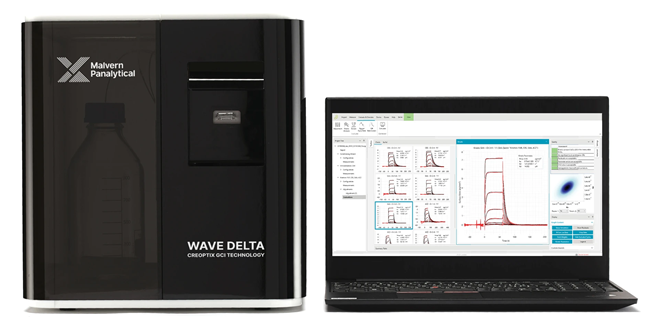
Image Credit: Malvern Panalytical
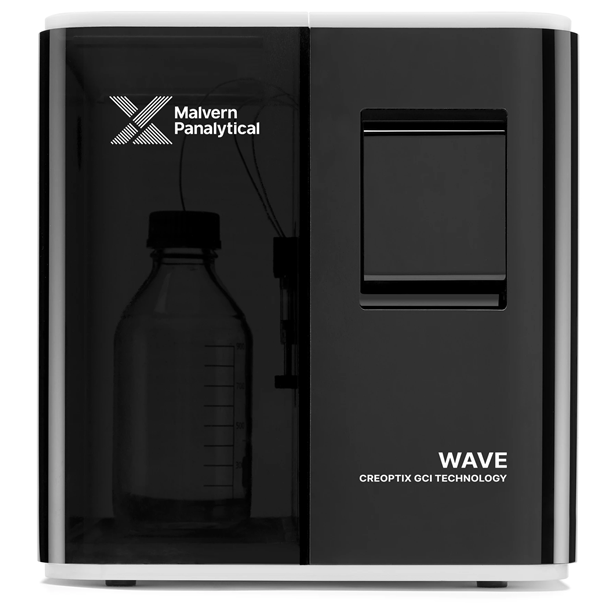
Image Credit: Malvern Panalytical
Advantages
The Creoptix® WAVEsystem is a revolutionary optical biosensor technology for real-time label-free binding kinetics that combines high sensitivity, crude sample resilience, and advanced software. With its unique Grating-Coupled Interferometry (GCI) technology and cutting-edge microfluidics, it is now feasible to obtain fresh data from challenging materials for unparalleled insight.
Label-free data like never seen before
The proprietary Grating-Coupled Interferometry (GCI) technology is housed within the WAVEsystem providing the sensitivity to operate with low immobilization levels and high ligand-to-analyte molecular weight (MW) ratios. In conjunction, the WAVEsystem includes a temperature-controlled autosampler that can handle two 48-vial racks, 96- or 384-well plates, or combinations thereof.
High sensitivity
The readout of the refractive index change is different in Grating-Coupled Interferometry (GCI) compared to Surface plasmon resonance (SPR). In SPR signals are rapidly attenuated and reduced to a limited number of interactions. In GCI the evanescent field travels along the entire waveguide, thus it can pick up signals from a more significant number of interactions, which results in better sensitivity.
Higher sensitivity and reliable kinetic analysis are made possible by this, as well as improved high signal-to-noise ratios, assessment of kinetics (ka, kd) and affinity (KD) from low pM to low mM, and from signals below 1 pg/mm2 (equal to <1 RU).
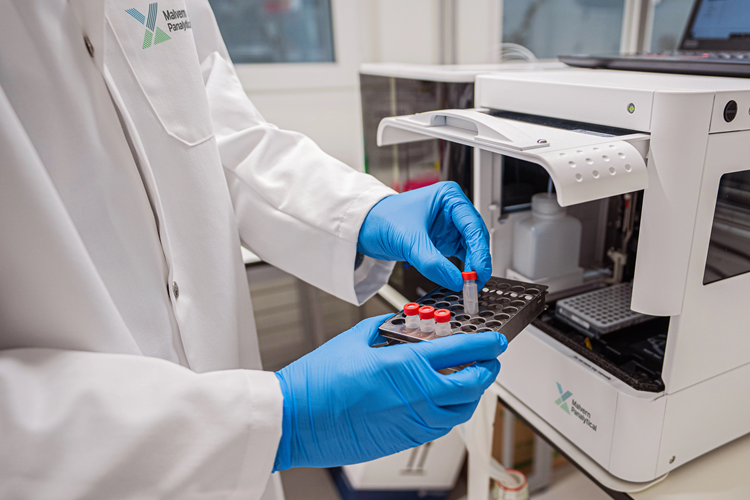
Image Credit: Malvern Panalytical
Large ligand-to-analyte molecular weight ratios
Sensitivity is frequently a barrier to accurate and consistent kinetic study of big drug targets and small molecule inhibitors. Large target-to-analyte molecular weight ratios provide a considerable barrier to standard label-free measurement and can significantly influence data quality.
The Creoptix® WAVEsystem is compatible with high ligand-to-analyte molecular weight ratios, offering excellent resolution and consistent kinetics at low immobilization levels for target-to-analyte molecular weight ratios of up to >1000:1. As a result, the sensitivity to precisely assess low-potency small molecules or fragments, or targets with low activity, is enhanced.
More signal, less noise
GCI generates an evanescent field that penetrates the bulk less deeply than SPR, reducing the disruption produced by changes in the bulk refractive index—this decrease in noise results in higher signal-to-noise ratios.
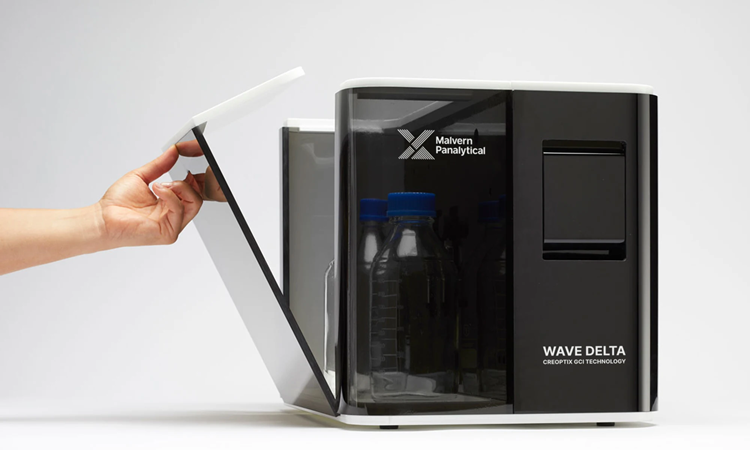
Image Credit: Malvern Panalytical
Robust readout
Instead of projecting a space-domain signal onto a CCD camera as with standard waveguide interferometry methods, the patented GCI technology generates an interference readout in the time domain and within the waveguide. Measuring refractive index changes on the sensor surface as time-resolved phase-shift signals gives a more robust readout regardless of temperature drifts or vibrations, translating to higher signal and temporal resolution.
Explore the Creoptix WAVEsystem
Creoptix WAVE: Explore the system's components
Video Credit: Malvern Panalytical
WAVEchip
WAVEchip®: A unique design and proprietary microfluidic sensor surface contained in a disposable cartridge that supports big particles up to 1000 nm, pathogenic samples, harsh solvents, and crude samples—all of which are typically only achievable with plate-based assays—for kinetic analysis that was previously unattainable.
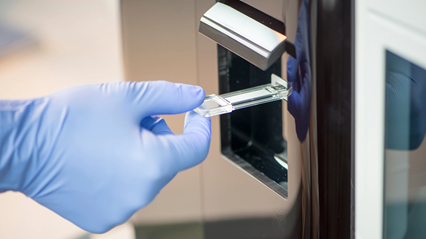
Image Credit: Malvern Panalytical
WAVEcontrol
Easily transition between samples and data using a straightforward, step-by-step procedure to set up the experiment. Analyse the experiments at the push of a button with the Direct Kinetics tool. Use waveRAPID, a cutting-edge method on the WAVEdelta instruments to acquire interaction kinetics by injections from a single well, up to ten times faster.
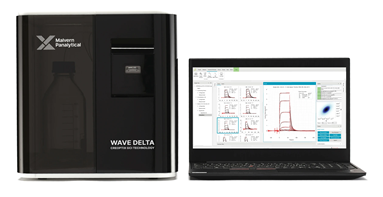
Image Credit: Malvern Panalytical
WAVEcare
For unmatched performance and high-quality kinetic data, carefree or basic assistance is provided.
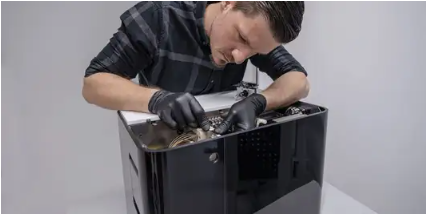
Image Credit: Malvern Panalytical
Specification
By pushing the boundaries of affinity range and sample compatibility, the Creoptix® WAVEsystem provides a breakthrough degree of kinetics analysis at users' fingertips. The system's superior data quality, sample compatibility, and automated software enhance drug development and provide for R&D opportunities.
General. Source: Malvern Panalytical
| Specification |
WAVE |
WAVEdelta |
| Noise (RMS) |
<0.01 pg/mm2 @ 1 Hz |
<0.01 pg/mm2 @ 1 Hz |
| Drift |
<0.3 pg/mm2/min |
<0.3 pg/mm2/min |
| Readout Frequency |
1 Hz, 10 Hz or 40 Hz |
1 Hz, 10 Hz or 40 Hz |
| Association Const. Range |
ka = 102 – 5x107 M-1 s–1 (small molecules)
ka = 102– 3x109 M-1 s–1 (large molecules) |
ka = 102 – 5x107 M-1 s–1 (small molecules)
ka = 102 – 3x109 M-1 s–1 (large molecules) |
| Dissociation Const. Range |
kd = 10–6 – 10 s–1 |
kd = 10–6 – 10 s–1 |
| Analysis Temperature Range |
15 °C – 40 °C |
4 °C – 45 °C
(max 20 °C below ambient) |
| Molecular Weight Limit |
No lower limit |
No lower limit |
| waveRAPID® Functionality |
No |
Yes |
Fluidics. Source: Malvern Panalytical
| Specification |
WAVE |
WAVEdelta |
| Flow Channels / Path |
2, parallel |
4, parallel |
| Channel Referencing |
1-4 and 4-1 or 2-3 and 3-2 |
Any combination of the 4 channels |
| Flow Cells |
Sealed, disposable, integrated into disposable WAVEchip |
Sealed, disposable, integrated into disposable WAVEchip |
| Flow Rate |
1 – 400 µl/min |
1 – 400 µl/min |
| Crude Sample Robustness |
Yes |
Yes |
Sample Handling. Source: Malvern Panalytical
| Specification |
WAVE |
WAVEdelta |
| Sample Capacity |
2x microtiter plates (96 or 384 well, standard or deep well) or vial racks (48 positions of 1.5ml) |
2x microtiter plates (96 or 384 well, standard or deep well) or vial racks (48 positions of 1.5ml) |
| Buffer |
1 buffer |
Automatic switching between 4 buffers |
| Degasser |
Built-in |
Built-in |
| Injection Volume |
< 450 µl, 100 µl typical |
< 450 µl, 100 µl typical |
| Sample Volume Required |
Injection volume plus 15-50 µl
(application dependent) |
Injection volume plus 15-50 µl
(application dependent) |
| Sample Storage Temperature |
Ambient or 4°C – 20°C regulated |
Ambient or 4°C – 20°C regulated |
| Sample Recovery |
Yes |
Yes |
| Automation |
120h of unattended operation |
120h of unattended operation |
Data Treatment. Source: Malvern Panalytical
| Specification |
WAVE |
WAVEdelta |
| Information Provided |
Kinetic and affnity data (ka, kd, KD) |
Kinetic and affnity data (ka, kd, KD) |
| Graphs |
Real-time curves, multiple curve overlays, fit, report point plots |
Real-time curves, multiple curve overlays, fit, report point plots |
| Data Extraction |
Curves, ka, kd, KD tables, graphs, reports |
Curves, ka, kd, KD tables, graphs, reports |
| Data Analysis |
Fully automated data evaluation |
Fully automated data evaluation |
| Kinetic Models |
Predefined models including 1:1 interaction, mass transport, heterogenous ligand, conformational change and bivalent |
Predefined models including 1:1 interaction, mass transport, heterogenous ligand, conformational change and bivalent |
| Direct Kinetics |
Yes |
Yes |
Robust with multiple applications. Dependable results with high sensitivity.”
Select Science - James Schouten, Principal Chemist, Mologic
Unrivaled high-sensitivity GCI data analysis
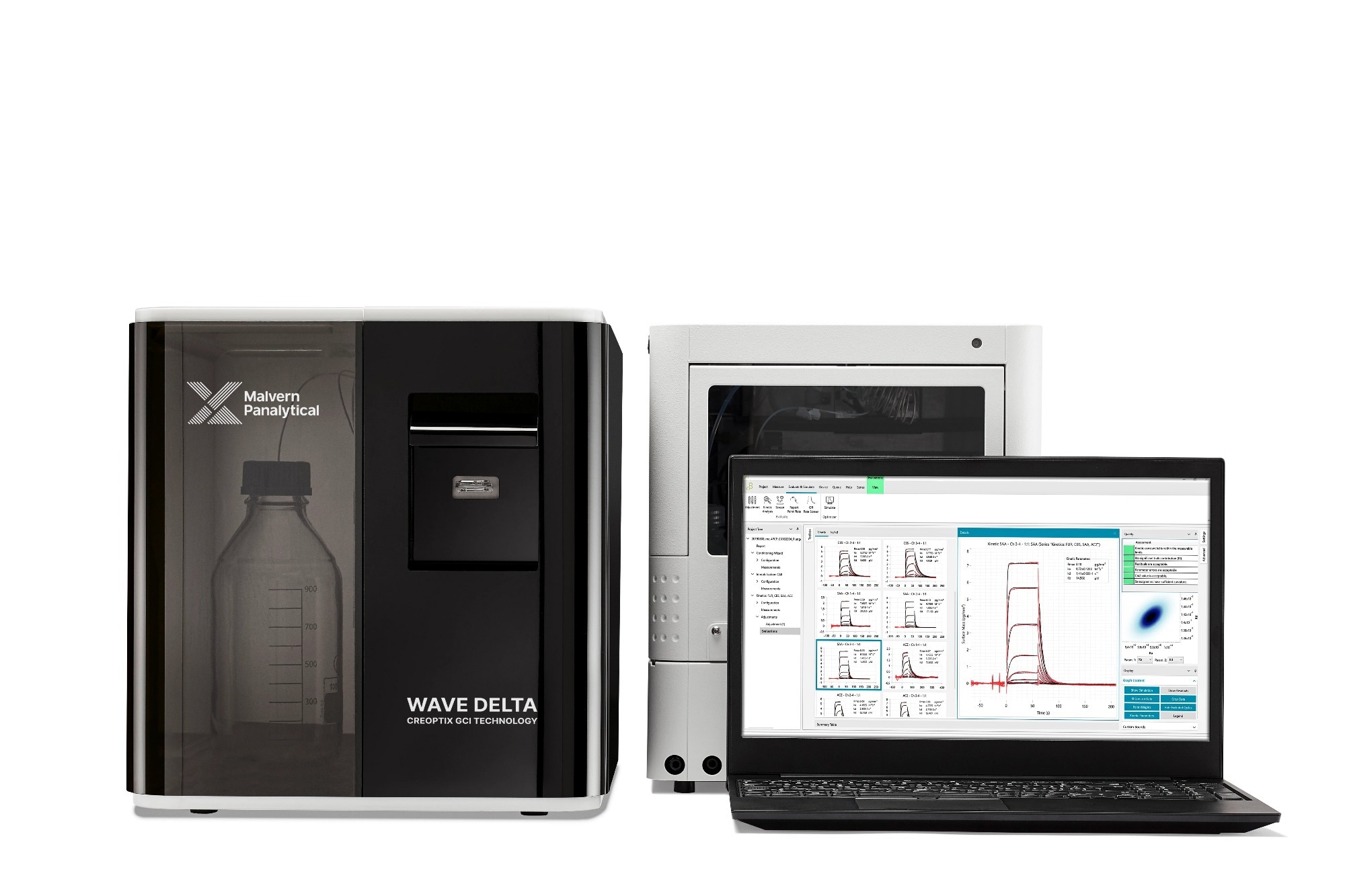
Image Credit: Malvern Panalytical
The Creoptix® WAVEsystem is a bioanalytical tool of the future with no-clog microfluidics and robust software. It leads the pace in GCI technology and label-free binding kinetics in real-time.